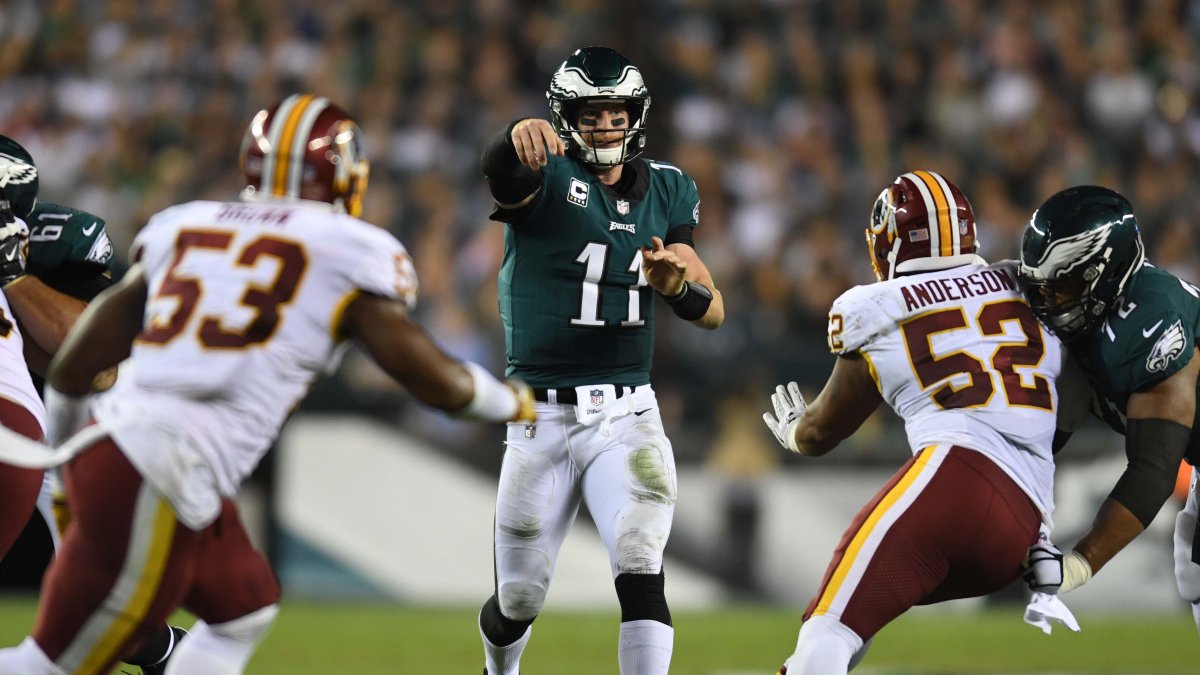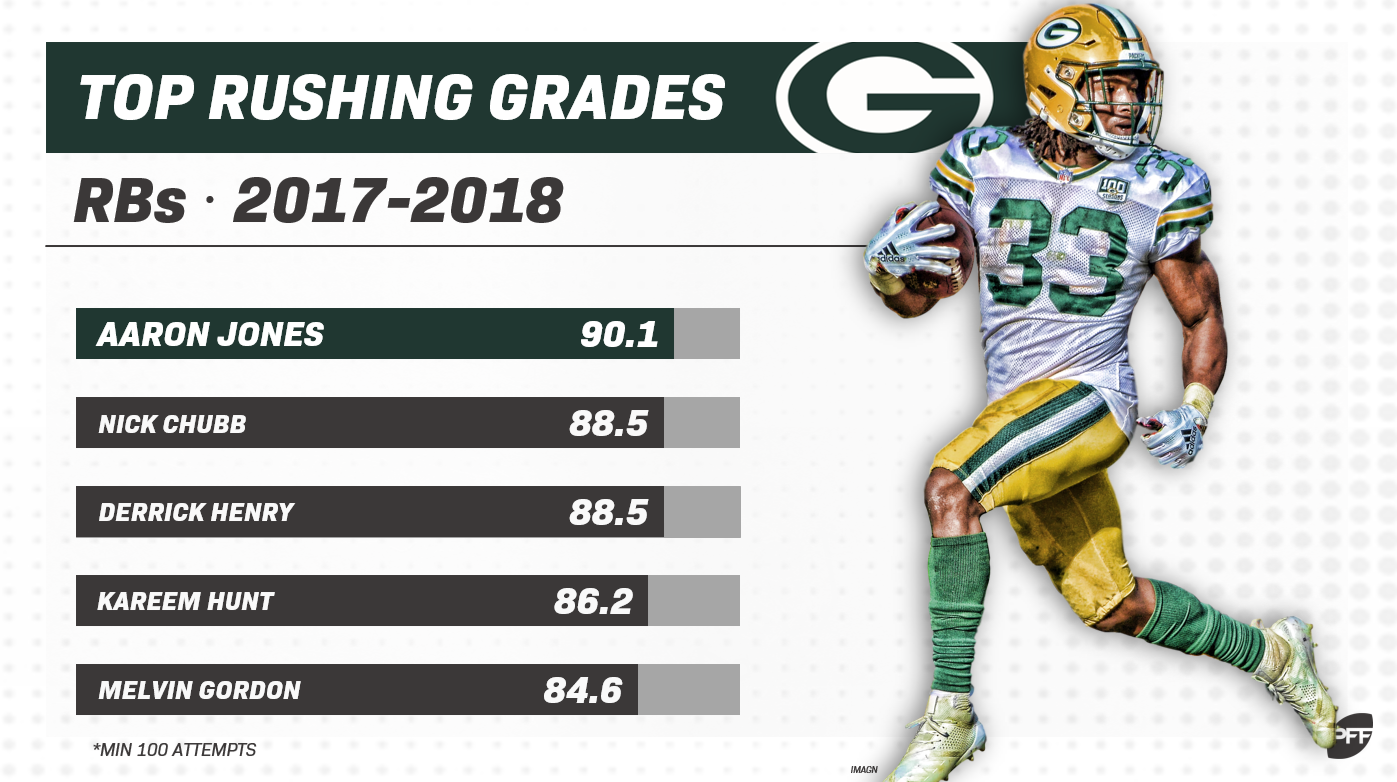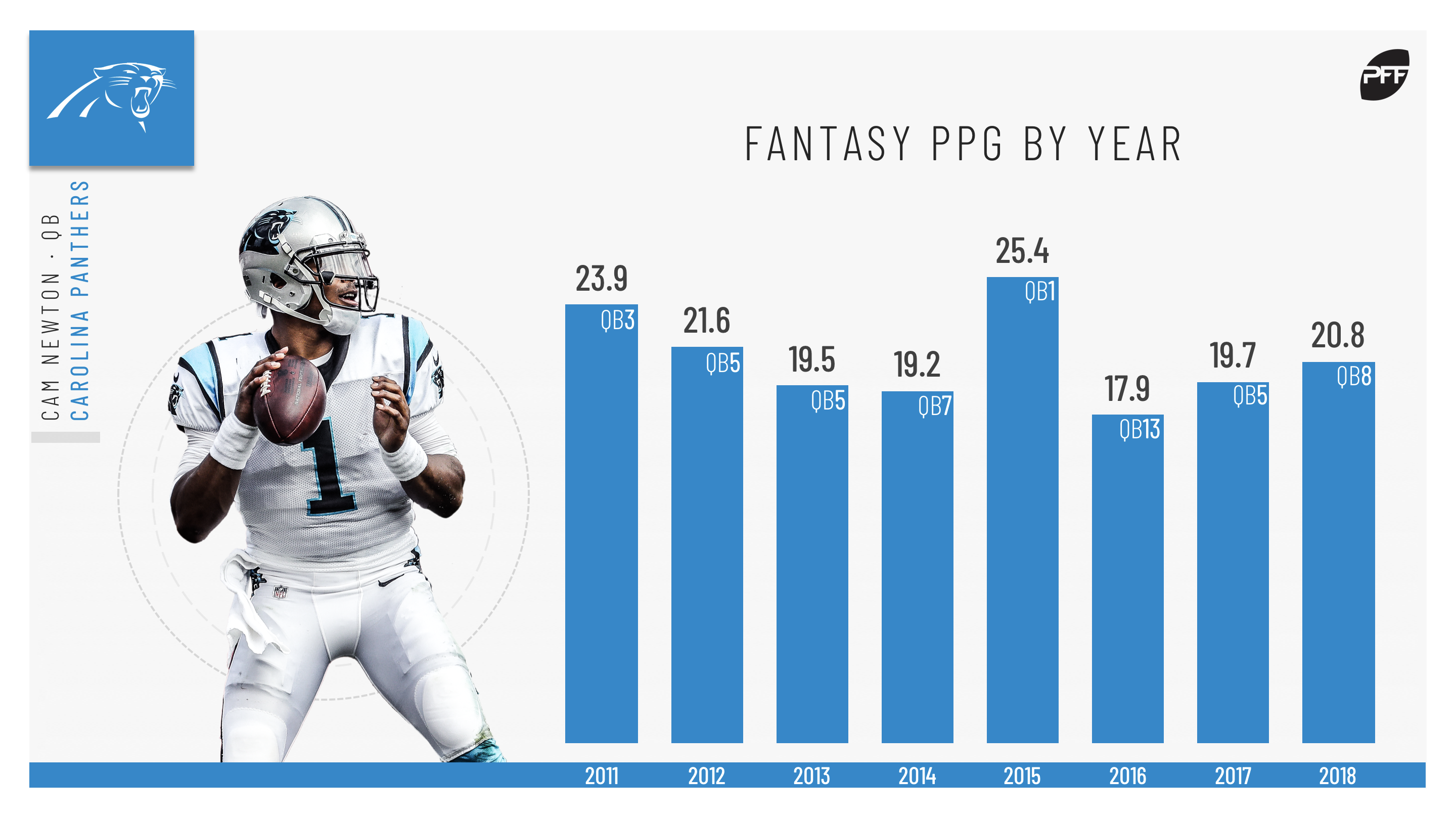It’s always good to have a fantasy football draft strategy, and that doesn’t start with the minute you sit down to actually conduct your draft. Personally, before my draft, I print out both a copy of the PFF Fantasy staff rankings and a copy of the ADP from the site I’m using to draft. As the draft progresses, I’ll cross off names from both lists and make my selections based on general research and our rankings.
By about the fifth or sixth round, the values become glaring. According to PFF’s sheet, there will always be a few players still listed who should have been taken off the board rounds ago but are still a few picks away according to my ADP sheet. I’ll then move these players to the top of my queue, as these are likely the current best values in my draft.
Individual site ADP is heavily influenced by casual drafters, and if it is true that PFF’s experts are the best in the business — and it is — then that site’s ADP is inherently inferior. One of the biggest advantages you can gain as a drafter is by exploiting your draft site’s specific ADP. You can use the method I outlined above (if you’re more old-school like I am), or you can use our DraftMaster tool, or, well, you can read this.
Below I will be listing a number of the most undervalued players (per PFF’s rankings) on NFL.com drafts. These players will be ranked in order of their NFL.com ADP. You can check out our rankings if you’re a subscriber.
James Conner, RB, Pittsburgh Steelers
(NFL.com ADP: RB10, 17th overall)
Earlier this year, I questioned why we weren’t treating Conner like we would Le’Veon Bell had he never left Pittsburgh. Last week, Pittsburgh beat writer Mark Kaboly confirmed Conner is still the team’s bell cow running back, and Jaylen Samuels’ touches won’t be coming at Conner’s expense. In my own rankings, I have Conner as the RB7 and as a first-round pick, well above NFL.com’s ADP.
Dalvin Cook, RB, Minnesota Vikings
(NFL.com ADP: RB12, 22nd)
Despite battling injuries and recovering from ACL surgery last season, Cook averaged 0.27 missed tackles forced per touch, which led the league and ranks fifth-best by any running back this past decade. From Week 11 (his first week off the injury report) until the end of last season, Cook played on 76% of the team’s snaps and averaged 15.7 fantasy points per game, which would have ranked 11th-best last year. Latavius Murray is no longer on the team, but Gary Kubiak now is. In 12 seasons as an offensive coordinator, Kubiak’s offense has ranked top-five in rushing yards nine times and top-12 12 times. In his last year in the league, Kubiak led the league in outside zone runs and outside zone run percentage. Over the last two seasons and of 38 qualifying running backs, Cook ranks fourth-best in yards per carry when running in outside zone. All of this adds up to make Cook look like a terrific bet to beat his ADP.
Aaron Jones, RB, Green Bay Packers
(NFL.com ADP: RB18, 36th)
Over the past two seasons, Jones leads all running backs in PFF rushing grade (90.4) and yards per carry (5.54). Since the start of the offseason, head coach Matt LaFleur has continually stated he wants a running back by committee approach in 2019. On what should be one of the NFL’s top offenses, even if he is just the lead back in a committee, that’ll still be enough to return value at current ADP.
Josh Jacobs, RB, Oakland Raiders
(NFL.com ADP: RB20, 41st)
Jacobs checks all of the boxes you want to see from a rookie running back: talent, promise of bell cow usage from the front office, and high invested draft capital. As Mike Clay has pointed out, seven of the 11 first round running backs drafted since 2012 have finished top-10 at the position in their rookie years. Jacobs has better odds of joining that group of names than he does of finishing this low.
Cooper Kupp, WR, Los Angeles Rams
(NFL.com ADP: WR23, 52nd)
Kupp averaged 15.4 fantasy points per game across his final seven games in 2017, which would have ranked 10th-best over the full season. Last season, Kupp averaged 16.6 fantasy points per game, which ranked 14th among wide receivers. If we exclude games he left early due to injury, that number jumps to 20.6, which would have ranked fifth-best last year. Any way you look at it, Kupp seems like a terrific value at ADP.
O.J. Howard, TE, Tampa Bay Buccaneers
(NFL.com ADP: TE6, 60th)
Howard has arguably been the league’s best tight end on a per-route or per-target basis since entering the league. Last season he tied for fifth at the position in fantasy points per game (12.1), despite splitting time with Cameron Brate and leaving two games early due to injury. He seems to be a perfect fit for the Bruce Arians offense and a breakout waiting to happen.
Kenyan Drake, RB, Miami Dolphins
(NFL.com ADP: RB30, 64th)
If the Dolphins rank perfectly average in plays per game this year — and not dead-last like where they ranked last year under Adam Gase — we should expect the Dolphins to run eight more plays per game this year. For perspective, that would have been worth an additional 60.1 fantasy points to Drake — the difference between him ranking 14th at the position and ninth. Though he’s deserving of a bell cow workload, he might not officially be the team’s “starter” this year. Even if that’s true, he’s the safest bet to lead Miami’s running backs in PPR points. Even if Kalen Ballage gets the majority of the team’s early-down carries, Drake will get the more valuable work, as the team’s primary pass-catching running back on a team that’s projected to finish dead-last in the win column. He’s not an exciting pick, but he is a good value.
Allen Robinson, WR, Chicago Bears
(NFL.com ADP: WR28, 67th)
Last season, Robinson ranked 21st in targets per game and 30th in fantasy points per game (11.8). Now, another year removed from ACL injury, expect even more volume and better efficiency in 2019. He’s a strong value in the middle sixth round of drafts on NFL.com.
Cam Newton, QB, Carolina Panthers
(NFL.com ADP: QB8, 92nd)
Since entering the league, Newton has ranked eighth (2018), fifth, 13th, first, seventh, fifth, fifth, and third in fantasy points per game. The shoulder concerns should finally be behind him, he might now have the best (healthy) receiving corps of his career, and he’s also due for a positive regression in the rushing department. Priced just about at his floor, with an ADP of QB8, he’s an easy value.
Geronimo Allison, WR, Green Bay Packers
(NFL.com ADP: WR42, 102nd)
Allison is Green Bay’s starting slot wide receiver, and, luckily for him, Aaron Rodgers loves throwing to the slot. Over the past 10 seasons, Rodgers has targeted wide receivers out of the slot on 25.6% of his throws (fourth-most among quarterbacks) with a 111.6 passer rating (best). Allison played in only four full games last season but averaged 7.3 targets and 15.0 fantasy points per game across this stretch. Since Rodgers was named the starter in 2008, Green Bay’s WR2 has yielded two WR1 seasons, four WR2 seasons, two WR3 seasons, and two WR4 seasons for fantasy. On NFL.com, however, you can get him at just a WR4 price-tag.
Courtland Sutton, WR, Denver Broncos
(NFL.com ADP: WR43, 103rd)
Sutton graded out poorly in his rookie year (77th of 118 qualifiers), but it’s hard not to get excited about the second-round pick’s potential in Year 2. His only real competition for targets are a rookie tight end, a 32-year-old wide receiver coming off of a late-season Achilles tear, and DaeSean Hamilton (who graded even worse than Sutton).
Larry Fitzgerald, WR, Arizona Cardinals
(NFL.com ADP: WR44, 104th)
Fitzgerald might not be a fun pick, but he is a strong value. Also, maybe immortal. Entering his 16th season in the league, Fitzgerald has ranked 28th, ninth, 17th, and 11th in fantasy points scored over the last four seasons, each ranking well above his current ADP. Fitzgerald's quantity (due to pace of play) and quality (due to the upgrade from Josh Rosen to Kyler Murray) of targets should also be much better this year.
Carson Wentz, QB, Philadelphia Eagles
(NFL.com ADP: QB11, 107th)
Over the past two seasons, Wentz ranks fifth among quarterbacks in fantasy points per game (19.8), behind only Patrick Mahomes, Deshaun Watson, Andrew Luck, and Russell Wilson. He’s now the healthiest he’s been since 2017 (when he finished third in fantasy points per game), and easily has the best supporting cast of his career. Wentz has no business going this low.
Delanie Walker, TE, Tennessee Titans
(NFL.com ADP: TE14, 125th)
Last year, Walker played in just one game before dislocating his ankle and spending the rest of the season on IR. Across the previous four seasons, Walker finished sixth, sixth, third, and seventh among tight ends in fantasy points per game. He also led Tennessee’s receivers in expected fantasy points per game in each of those seasons — and that sort of volume could return in 2019, with Walker’s former tight ends coach (Arthur Smith) now calling the plays.
Anthony Miller, WR, Chicago Bears
(NFL.com ADP: WR51, 126th)
Last season, Mitchell Trubisky averaged a 103.7 passer rating when targeting wide receivers out of the slot. When targeting wide receivers split out wide, that number was just 82.4. In 2017, Trubisky’s favorite target was slot wide receiver Kendall Wright, who amassed 51% more targets than the next-closest player. In 2016 (in college), Trubisky’s favorite target was another slot wide receiver, Ryan Switzer, who drew 44% more targets than the next-closest player. In 2017 (in college), Anthony Miller ranked sixth-best of 179 qualifying wide receivers in yards per route run from the slot (3.43). Last season, Miller ran 69% of his routes from the slot, and wasn’t Trubisky’s favorite target. Perhaps this was due to the fact that (since Week 3) Miller was dealing with a bad shoulder injury that popped out “maybe five to six times” throughout the season. In spite of it, he still led the team in receiving touchdowns (seven). Like with Allison, I’m expecting big things in 2019 and for similar reasons.
Golden Tate, WR, New York Giants
(NFL.com ADP: WR52, 129th)
Tate is going to hurt you to start the year (four-game suspension), but he’ll be back for you when it matters most. Tate has long been a favorite of mine, and, I think, a good bet to outscore Sterling Shepard on a per-game basis and return mid-range WR3 value when he’s on the field. The early-season zeroes are going to be worth that return on investment.
Lamar Jackson, QB, Baltimore Ravens
(NFL.com ADP: QB16, 131st)
More so than any other player, Jackson is my favorite ADP value in current drafts, and he’s even lower on NFL.com than most of the places I’ve been drafting.
Greg Olsen, TE, Carolina Panthers
(NFL.com ADP: TE21, 158th)
Over the past two seasons, Olsen has spent 19 games either inactive or in the injury report, but prior to that, he posted three consecutive 1,000-yard seasons and five consecutive top-seven fantasy finishes. At his NFL.com ADP, it’s worth the gamble that he still has a little bit of gas left in the tank.
Jamison Crowder, WR, New York Jets
(NFL.com ADP: WR60, 159th)
Crowder has shown flashes of brilliance when healthy, and the pairing with Adam Gase seems near-ideal. He might not be a league-winner but he has decent odds of leading the team in fantasy points and should benefit from Robby Anderson’s league-worst cornerback schedule.
Jack Doyle, TE, Indianapolis Colts
(NFL.com ADP: TE22, 160th)
Last season, Eric Ebron was out-snapped (331 to 164) and out-targeted (32 to 22) by Doyle in games both players were active. Doyle very well could be a wasted pick, or he could be Indianapolis’ TE1. At NFL.com’s price tag, it’s worth taking that gamble.
Donte Moncrief, WR, Pittsburgh Steelers
(NFL.com ADP: WR63, 166th)
If Moncrief is the clear WR2 behind JuJu Smith-Schuster, he’s a tremendous value at ADP. Based on his lackluster NFL resume and the meager contract he just signed, that doesn’t feel like a given. However, that possibility has looked much more likely since the start of OTAs. The Athletic’s Mark Kaboly said Moncrief “looks like a slam-dunk No. 2 receiver.” He’ll need to beat out James Washington, Ryan Switzer, and Diontae Johnson, but if he can, he’s a safe bet to return value.
Adam Humphries, WR, Tennessee Titans
(NFL.com ADP: WR65, 175th)
Humphries ranked 32nd in PFF grade and 24th in fantasy points last year. Somehow, he’s going undrafted in the majority of leagues. Granted, he’s on a new team, but he also chose that team for a reason – and over New England offering him more money. Maybe it was a desire for more consistent usage? In Week 1 of preseason, Humphries saw six targets on seven routes.
Albert Wilson, WR, Miami Dolphins
(NFL.com ADP: WR70, 185th)
As far as man crushes go, my love for Wilson borders on embarrassing. Of course, I’m not going to let Wilson go this low when I’m drafting on NFL.com. He just needs to get healthy, and, ideally, earn full-time starting slot duties before I move him up another few rounds.
Josh Gordon, WR, New England Patriots
(NFL.com ADP: WR74, 208th)
Gordon is currently going in the last rounds of NFL.com drafts (or undrafted) but ranks a great deal higher in our rankings. Sure, he might not play a single game all year, but his upside is far more valuable than the cost to acquire him. Last season, while with the Patriots, Gordon averaged 2.15 yards per route run (12th-best), not far off his numbers across his previous three seasons: 2.01, 2.20, and 2.68. Gordon also averaged 11.8 fantasy points per game with New England, which would have ranked 29th. No other wide receivers near his ADP have his talent or this sort of upside.
Other players who are going undrafted who shouldn’t be: C.J. Anderson, Ted Ginn Jr., Tony Pollard, Alfred Morris, Brian Hill, Mecole Hardman, Justice Hill, Paul Richardson Jr., Darren Waller, Chase Edmonds, Phillip Dorsett, Quincy Enunwa, Trey Quinn, Marquise Goodwin, Malcolm Brown, Darwin Thompson, Ty Montgomery, and Tyler Eifert.





 © 2025 PFF - all rights reserved.
© 2025 PFF - all rights reserved.